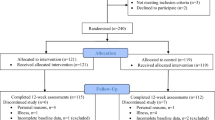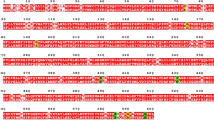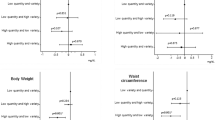Abstract
Background:
Enhanced cyclooxygenase-2 (COX-2) expression is associated with carcinogenesis, ischemia, angiogenesis, inflammation, and neurodegeneration. The preventing effect of aspirin and nonsteroidal anti-inflammatory drugs is partly due to inhibition of the COX-2 enzyme. Fruit and vegetables (FVs) contain numerous compounds that may decrease disease risk by several different mechanisms, for example through the inhibition of COX-2 activity.
Objective:
We tested the hypothesis that an increased intake of FVs would modulate the COX-2 expression in peripheral blood cells.
Design:
A strictly controlled dietary crossover study (n=39). After 1 week run-in period with no FVs in the diet, one group was given two portions of FVs (2 FV), while another group was given five portions (5 FV) daily for 14 days. Following a 2 weeks washout period and 1 week run-in, the regimens were switched between the groups. Gene expression analysis of COX-2 mRNA in blood samples was performed by quantitative real-time-PCR.
Results:
No significant treatment effect of diet intervention was found in the crossover analyses (P=0.74). However, the individual variation in response may seem large.
Conclusions:
These data does not contradict the recommendations for an increased intake of FVs. Further studies on expression directly and indirectly, through analysis of factors regulating and being regulated by COX-2, should be carried out. A first step would be to evaluate the correspondence between COX-2 mRNA expression and products of the COX pathway, like prostaglandins. Naturally occurring polymorphisms of COX-2 promoters and coding regions might contribute to functional variations and response to different diets.
Sponsorship:
Norwegian Research Council, National Nutrition Council, Throne Holst Foundation for Nutrition Research, Freia Chokoladefabriks Medisinske Fond and the Norwegian Cancer Society.
This is a preview of subscription content, access via your institution
Access options
Subscribe to this journal
Receive 12 print issues and online access
$259.00 per year
only $21.58 per issue
Buy this article
- Purchase on SpringerLink
- Instant access to full article PDF
Prices may be subject to local taxes which are calculated during checkout
Similar content being viewed by others
References
Agudo A, Slimani N, Ocke MC & Naska A (2002): Vegetable and fruit consumption in the EPIC cohorts from 10 European countries. IARC Sci.Publ. 156, 99–103.
Almendingen K, Trygg K & Pedersen JI (1998): An assessment of the use of simple methods to predict individual energy intakes for intervention studies. Eur. J. Clin. Nutr. 52, 54–59.
Altmann DG (1991): Practical Statistics for Medical Research. London: Chapman and HAll/CRC.
Angelis-Stoforidis P, Vajda FJ & Christophidis N (1998): Effects of non-steroidal anti-inflammatory drugs (NSAIDs) on human polymorphonuclear leucocyte function in buffer and plasma. Clin. Exp. Rheumatol. 16, 703–708.
Aronson WJ, Glaspy JA, Reddy ST, Reese D, Heber D & Bagga D (2001): Modulation of omega-3/omega-6 polyunsaturated ratios with dietary fish oils in men with prostate cancer. Urology 58, 283–288.
Bagga D, Wang L, Farias-Eisner R, Glaspy JA & Reddy ST (2003): Differential effects of prostaglandin derived from omega-6 and omega-3 polyunsaturated fatty acids on COX-2 expression and IL-6 secretion. Proc. Natl. Acad. Sci. USA 100, 1751–1756.
Blacklock CJ, Lawrence JR, Wiles D, Malcolm EA, Gibson IH, Kelly CJ & Paterson JR (2001): Salicylic acid in the serum of subjects not taking aspirin. Comparison of salicylic acid concentrations in the serum of vegetarians, non-vegetarians, and patients taking low dose aspirin. J. Clin. Pathol. 54, 553–555.
Blomhoff R (1998): Fruit and vegetables in the prevention of cancer. Tidsskr. Nor Laegeforen. 118, 3462–3465.
Brevik A, Andersen LF, Karlsen A, Trygg KU, Blomhoff R & Drevon CA (2004a): Six carotenoids in plasma used to assess recommended intake of fruits and vegetables in a controlled feeding study. Eur. J. Clin. Nutr. 58, 1166–1173.
Brevik A, Rasmussen SE, Drevon CA & Andersen LF (2004b): Urinary excretion of flavonoids reflects even small changes in the dietary intake of fruits and vegetables. Cancer Epidemiol. Biomarkers Prev. 13, 843–849.
Bustin SA (2002): Quantification of mRNA using real-time reverse transcription PCR (RT-PCR): trends and problems. J. Mol. Endocrin. 29, 23–39.
Capone ML, Tacconelli S, Sciulli MG, Grana M, Ricciotti E, Minuz P, Di Gregorio P, Merciaro G, Patrono C & Patrignani P (2004): Clinical pharmacology of platelet, monocyte, and vascular cyclooxygenase inhibition by naproxen and low-dose aspirin in healthy subjects. Circulation 109, 1468–1471.
de Pascual-Teresa S, Johnston KL, Dupont MS, O'Leary KA, Needs PW, Morgan LM, Clifford MN, Bao Y & Williamson G (2004): Quercetin metabolites downregulate cyclooxygenase-2 transcription in human lymphocytes ex vivo but not in vivo. J. Nutr. 134, 552–557.
Dommels YE, Haring MM, Keestra NG, Alink GM, van Bladeren PJ & van Ommen B (2003): The role of cyclooxygenase in n-6 and n-3 polyunsaturated fatty acid mediated effects on cell proliferation, PGE(2) synthesis and cytotoxicity in human colorectal carcinoma cell lines. Carcinogenesis 24, 385–392.
DuBois RN (2003): Cyclooxygenase-2 and colorectal cancer. Prog. Exp. Tumor Res. 37, 124–137.
Fritsche E, Baek SJ, King LM, Zeldin DC, Eling TE & Bell DA (2001): Functional characterization of cyclooxygenase-2 polymorphisms. J. Pharmacol. Exp. Ther. 299, 468–476.
Goppelt-Struebe M, Esslinger B & Kunzendorf U (2003): Failure of cyclosporin A to induce transforming growth factor beta (TGF-beta) synthesis in activated peripheral blood lymphocytes. Clin. Transplant 17, 20–25.
Hla T & Neilson K (1992): Human cyclooxygenase-2 cDNA. Proc. Natl Acad Sci USA 89, 7384–7388.
Humar B, Giovanoli O, Wolf A, Attenhofer M, Bendik I, Meier R, Muller H & Dobbie Z (2000): Germline alterations in the cyclooxygenase-2 gene are not associated with the development of extracolonic manifestations in a large Swiss familial adenomatous polyposis kindred. Int. J. Cancer 87, 812–817.
Jack DB (1997): One hundred years of aspirin. Lancet 350, 437–439.
Janssen PL, Hollman PC, Venema DP, van Staveren WA & Katan MB (1996): Salicylates in foods. Nutr. Rev. 54, 357–359.
Kim YC, Yi SY, Mang HG, Seo YS, Kim WT & Choi D (2002): Pathogen-induced expression of cyclo-oxygenase homologue in hot pepper (Capsicum annuum cv. Pukang). J. Exp. Botany 53, 383–385.
Kimura T, Iwase M, Kondo G, Watanabe H, Ohashi M, Ito D & Nagumo M (2003): Suppressive effect of selective cyclooxygenase-2 inhibitor on cytokine release in human neutrophils. Int. Immunopharmacol. 3, 1519–1528.
Lampe JW (2003): Spicing up a vegetarian diet: chemopreventive effects of phytochemicals. Am. J. Clin. Nutr. 78, 579S–583S.
Li RW, Lin GD, Myers SP & Leach DN (2003): Anti-inflammatory activity of Chinese medicinal vine plants. J. Ethnopharmacol. 85, 61–67.
Little J, Sharp L, Duthie S & Narayanan S (2003): Colon cancer and genetic variation in folate metabolism: the clinical bottom line. J. Nutr. 133, 3758S–3766S.
Manson MM (2003): Cancer prevention—the potential for diet to modulate molecular signalling. Trends Mol.Med. 9, 11–18.
Meade EA, McIntyre TM, Zimmerman GA & Prescott SM (1999): Peroxisome proliferators enhance cyclooxygenase-2 expression in epithelial cells. J. Biol. Chem. 274, 8328–8334.
Papafili A, Hill MR, Brull DJ, McAnulty RJ, Marshall RP, Humphries SE & Laurent GJ (2002): Common promoter variant in cyclooxygenase-2 represses gene expression: evidence of role in acute-phase inflammatory response. Arterioscler. Thromb. Vasc. Biol. 22, 1631–1636.
Paterson JR & Lawrence JR (2001): Salicylic acid: a link between aspirin, diet and the prevention of colorectal cancer. Q. J. Med. 94, 445–448.
Plummer SM, Hill KA, Festing MF, Steward WP, Gescher AJ & Sharma RA (2001): Clinical development of leukocyte cyclooxygenase 2 activity as a systemic biomarker for cancer chemopreventive agents. Cancer Epidemiol. Biomarkers Prev. 10, 1295–1299.
Swain AR, Dutton SP & Truswell AS (1984): Salicylates in foods. J. Am. Dietetic. Assoc. 85, 950–960.
van't Veer P, Jansen MC, Klerk M & Kok FJ (2000): Fruits and vegetables in the prevention of cancer and cardiovascular disease. Public Health Nutr. 3, 103–107.
Vane J (2003): The mechanism of action of anti-inflammatory drugs. Int. J. Clin. Pract. Suppl 2.
Venema DP, Hollman PC, Janssen KPLTM & Katan MB (1996): Determination of acetylsalicylic acid and salicylic acid in foods, using HPLC with fluorescence detection. J. Agric. Food Chem. 44, 1762–1767.
Wargovich MJ, Woods C, Hollis DM & Zander ME (2001): Herbals, cancer prevention and health. J. Nutr. 131, 3034S–3036S.
Warner TD, Giuliano F, Vojnovic I, Bukasa A, Mitchell JA & Vane JR (1999): Nonsteroid drug selectivities for cyclo-oxygenase-1 rather than cyclo-oxygenase-2 are associated with human gastrointestinal toxicity: a full in vitro analysis. Proc. Natl. Acad. Sci. USA 96, 7563–7568.
Wu AW, Gu J, Ji JF, Li ZF & Xu GW (2003): Role of COX-2 in carcinogenesis of colorectal cancer and its relationship with tumor biological characteristics and patients' prognosis. World J. Gastroenterol. 9, 1990–1994.
Xu XM, Sansores-Garcia L, Chen XM, Matijevic-Aleksic N, Du M & Wu KK (1999): Suppression of inducible cyclooxygenase 2 gene transcription by aspirin and sodium salicylate. Proc. Natl. Acad. Sci. USA 96, 5292–5297.
Acknowledgements
We thank assistant professor Kerstin Ulla Trygg for her help with hosting our participants, serving and preparing the food. We thank bioengineers Borghild Arntsen, Anne Randi Alvestad and Hanne Schulz for collection of blood samples. Finally, we thank Jette Jackobsen at the Danish Food and Veterinary Administration for determining the carotenoid content of the experimental diet. We acknowledge the financial support from The Norwegian Research Council, National Nutrition Council, Throne Holst Foundation for Nutrition Research, Freia Chokoladefabriks Medisinske Fond and the Norwegian Cancer Society.
Author information
Authors and Affiliations
Corresponding author
Additional information
Guarantor: Professor Dr Med M Vatn.
Contributors: None of the authors had any financial conflicts in the preparation or submission of the manuscript. All co-workers took part in proof-reading the manuscript and made suggestions for changes that were implemented. KA conducted all the statistical analyses and wrote most of the paper; AB and LFA designed and carried out the primary study (Brevik et al, 2004a, 2004b); LFA and KA initiated the present study; PAA, HTH and DAN planned the methodological approach for analyzing COX-2 in peripheral blood cells; HTH and DAN did the laboratory work on the blood samples; MV and PAA forwarded the idea of looking at COX-2 as a diet marker; MV provided advice on medical issues relevant to clinical work.
Rights and permissions
About this article
Cite this article
Almendingen, K., Brevik, A., Nymoen, D. et al. Modulation of COX-2 expression in peripheral blood cells by increased intake of fruit and vegetables?. Eur J Clin Nutr 59, 597–602 (2005). https://doi.org/10.1038/sj.ejcn.1602110
Received:
Revised:
Accepted:
Published:
Issue date:
DOI: https://doi.org/10.1038/sj.ejcn.1602110



